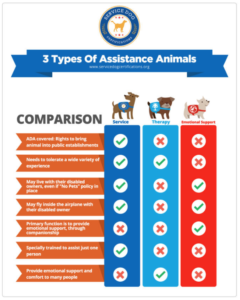Welcome to the Week’s Review of Canine Social Media
Welcome to this Special Feature on the DoggieU K9 Blog for an update on this week’s dog-related social media from around the world. There are so many stories. Here we will share some of the best stories this week.
Enjoy & share them.
Service Animals vs. Emotional Support Animals — Is There a Difference?
Everything you need to know about the cutest medical equipment around.
- The number of people owning emotional support animals has grown tremendously in the last decade. The prevalence of these animals has left many confused — what is an emotional support animal, exactly? Who might need one? Is it just another kind of service animal?
- The truth is, even though emotional support animals and service animals both serve people with disabilities, they couldn’t be more different.

Source: servicedogcertifications.org Service Dogs
-
Each support dog training facility has a unique but similar approach to training a support dog. Puppies are sent to homes to teach the basic obedience skills booth at home and in public. During this time the puppy also attends training classes for more in depth preparation.
-
Once a service dog is matched with an individual, they are trained on specific skills that can help the person better manage their disability. For example, they can be taught to detect seizures before they happen or guide a person away from dangers in the environment. Service dogs are certified & considered the equivalent of “medical equipment” or a “medical assistant.”
- Service dog training must comply with the United States Federal Service Dog Laws which are part of the Americans with Disabilities Act. (ADA). However, while the ADA has very strict and clear regulations about what constitutes a service dog, there is no government agency that ‘police’s’ or enforces that these rules are adhered to. It is important contact reputable organizations that train these amazing dogs.
Emotional Support Animals -
On the other hand, emotional support animals don’t qualify as official service animals. Emotional support animals are for people with emotional disabilities or mental illnesses, like depression, anxiety, obsessive-compulsive disorder, PTSD and more.
-
The primary job of an emotional support animal is to provide the handler with emotional support and comfort. An emotional support animal itself does not have to be specially certified or trained. However, the person who owns the emotional support animal must have an Emotional Support Animal (ESA) letter, which is written by a mental health professional who knows and has evaluated the person.
Therapy Dogs
-
Therapy dogs visit hospitals, nursing homes, schools and libraries to engage “therapeutic contact” (petting or just spending time with people. People are encouraged to pet therapy dogs. That’s part of the dog’s job!

-
Therapy dogs are pets who generally work with their owners on a volunteer basis. The dogs often wear vests or bandanas with patches identifying them as therapy dogs.
-
Therapy dogs must undergo training and in some areas must pass the Canine Good Citizen (CGC) test and therapy dog certification test. The training is not as extensive as service dog training and often includes a basic manners/obedience class and exposing a dog to a variety of people and situations.
-
Therapy dogs and their handlers have no special access rights under the ADA.. They visit hospitals and other facilities with the permission of the facility.
Regardless of the dog’s area of expertise, they offer a valuable service to help improve the lives of the people they serve.
This chart explains the duties/activities of the various types of Assistance Animals
[Link]
Anti-Anxiety Spray harnesses a pet owner’s scent to resolve dog anxiety
- The creators of K9 Comfort Spray, have released their latest formulation—Earmuffs Anti-Anxiety Spray—which contains a dog owner’s scent molecules to offer a sense of calm and comfort for pets when used before stressful events.
-
The Anti-Anxiety Spray is formulated to bring a sense of calm and comfort when used prior to any stressful event. Sounds that dogs fear often include:

- Fireworks
- Thunderstorms
- Loud Vehicles including airplanes
- Crying Babies
- Alarms/Sirens
- Vacuums
-
Research by Emory University found that dog owner’s scent is scientifically proven to trigger happiness within dog’s brain. MRIs confirmed, over any other scent (including sausage!), the owner’s scent created the most positive, happy emotions -even when not present! When a dog breathes in Earmuffs Anti-Anxiety Spray containing their owner’s scent, the results are a calmer, more relaxed dog.
-
The Anti-Anxiety Spray is 100% natural and includes essential oils known for calming properties such as lavender, spikenard, neroli, and Human Molecular Extraction (HME), a highly concentrated extract of the dog owner’s scent molecules. HME has no noticeable scent to humans. This combination relaxes dogs while decreasing noise-induced anxiety.
-
To obtain the customized scent, pet parents receive a collection kit in the mail, rub several cotton pads around their bodies, and send it back to be processed. Pet owners spray their dog’s favorite blanket, bed, toy, or bandana with the product prior to them being exposed to loud noises or changes in their environment.
- [Link]
Is Fear of Loud Noises Common in Dogs?
Here is an interesting article that explores fear of noises in our canine family. It suggests that “A dog’s age and breed may predict how likely he is to be fearful of loud sounds.”
The article highlights 4 key points:
- A high percentage of dogs become frightened by loud sounds such as fireworks, thunder or gunshots.
- Data shows that some breeds of dogs are markedly less susceptible to fear of loud noises.
- Older dogs are more likely to have a negative emotional response to intense sounds.
- There are some simple procedures to help reduce the feelings of fear evoked by occasional loud sounds.
Read more details here [Link]
